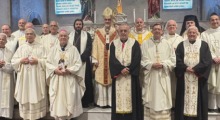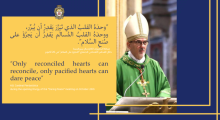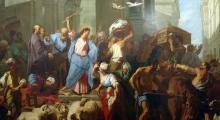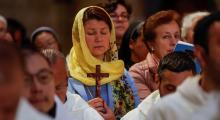Issued by the Catholic Center for Studies and Media - Jordan. Editor-in-chief Fr. Rif'at Bader - موقع أبونا abouna.org
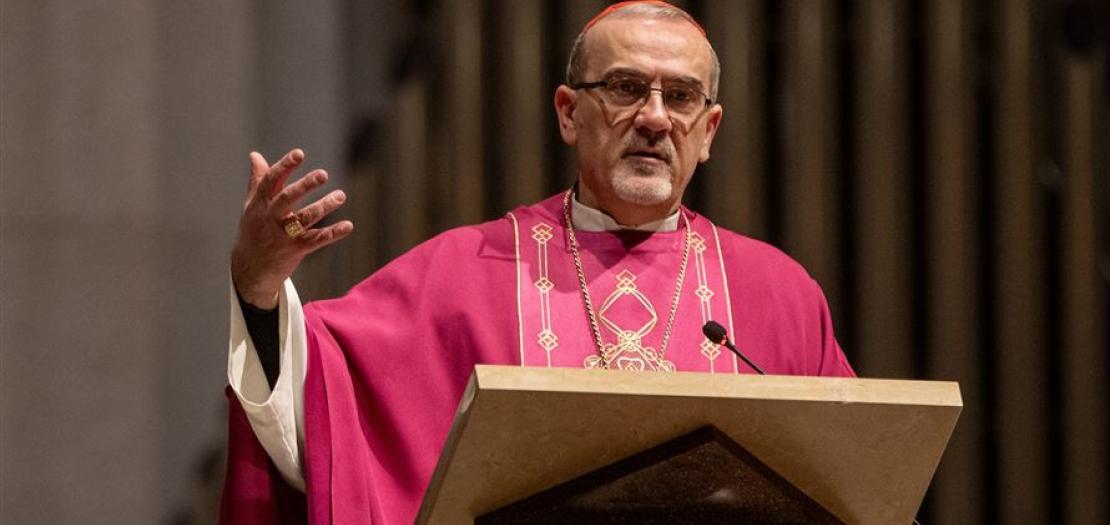
Following is the text of the meditation by His Beatitude Cardinal Pierbattista Pizzaballa, Latin Patriarch of Jerusalem, for the fourth Sunday of Lent, dated April 6, 2025:
Today, too, we try to understand the passage from this Sunday’s Gospel (John 8:1-11) by starting with a small detail.
We are in the temple, where Jesus has come from the Mount of Olives. He has sat down and is teaching the people who have gathered around him (John 8:1-2). While he is teaching, scribes and Pharisees bring an adulterous woman to him and ask him to pronounce judgment on her. But Jesus remains silent and writes with his finger on the ground (Jn 8:6). And because they insist, Jesus says the famous words: “Let the one among you who is without sin be the first to throw a stone at her,” (John 8:7) then he bends down again and continues to write on the ground. (John 8:8)
This last detail is strange: Jesus bends down again and writes a second time. It is strange that he does it a first time. It is even stranger that the evangelist John emphasizes that he also does it a second time
The Holy Scriptures themselves can help us to understand this seemingly strange reference by the evangelist.
At the end of chapter 31 of the Book of Exodus, we read that God, after speaking at length with Moses about all the laws he had delivered to Israel, “gave him the two tablets of the covenant, the stone tablets inscribed by God’s own finger.” (Ex 31:18)
We find a first reference: indeed, v. 6 of today’s Gospel also says that Jesus writes on the ground with His finger.
But, as we said, the strange thing is that this gesture is repeated twice. Even the Tablets of the Law needed to be written twice.
The former were in fact destroyed by Moses as a symbol of the people’s sin of unfaithfulness and idolatry: the covenant that had just been made was immediately broken. (Ex 32)
But God had not destroyed them all, as he had originally intended, and in the 34th chapter of Exodus He gives Moses two more tablets of the covenant, tablets that God had rewritten. (Ex 34:1, 28)
Those who had led the woman to Jesus by pronouncing a death sentence on her could not, of course, have missed this allusion. Jesus writes twice, because that is how God deals with His people and with every person. He always gives a second chance. He offers it to everyone, because we all need it.
Even the scribes and Pharisees who watch him write need it. They have the chance to remember that they too belong to a people of sinners, of adulterers, a people who need a second chance.
However, Jesus does not simply shift the focus from the sin of the woman to the sin of all: He does not deny the sin of the woman, just as Moses did not deny the sin of his people before God, nor does he trivialize it. Jesus does not minimize her responsibility, but neither does He crush her under the weight of her guilt.
First, Jesus speaks to her (“Jesus straightened up and said to her, “Woman, where are they?” (John 8:10) The violence of her accusers had taken away her speech; Jesus gives it back to her, restores her dignity.
Then He gives her back to herself and her responsibility: He is not the one who condemns the woman (“Jesus said, “Neither do I condemn you” (John 8:11) for He has not come to condemn (“I did not come to condemn the world but to save the world.” (John 12:47) Rather, it is precisely those who do evil who ultimately condemn themselves.
Ultimately, he brings her back to the right path, freeing her from the need to persist in her own sin, to repeat her sin (“Go, and from now on do not sin any more.” (John 8:11) So, Jesus offers her a second chance.
But he doesn’t just offer it to her! The Pharisees and the elders can also start a new journey from there: They too set out (“they went away one by one, beginning with the elders”. (John 8:9)
Anyone who experiences God’s mercy can, if he wishes, start anew, can be born again, can set out on his journey.
+ Pierbattista


